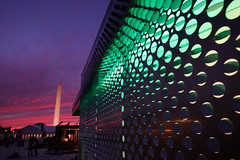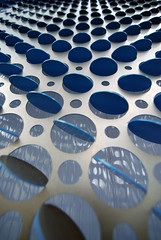Lumenhaus is Virginia Tech’s 2009 entry to the US Solar Decathlon competition, an educational project of the U.S. Department of Energy supported by DOE's National Renewable Energy Laboratory. This green house was inspired by the Farnsworth House by Mies Van Der Rohe. It features glass walls facing the north and south to maximize daylight, and the fully automated Eclipsis System of independent sliding layers filters light in beautiful, flowing patterns throughout the day...
Thursday, October 15, 2009
Monday, October 12, 2009
2009 Solar Decathlon
Friday, October 9, 2009
Robert Dunay introduces LUMENHAUS
via TreeHugger
Thanks to David DeFranz
http://www.youtube.com/watch?v=zvRnzvnVjMo&feature=player_embedded
LUMENHAUS on EcoHomeMagazine
Virginia Tech’s Lumenhaus
Virginia Tech uses sliding glass walls to expand the living space of its Solar Decathlon 2009 house.
Coolest features: Eclipsis shutter system made from stainless steel and a translucent polycarbonate panel filled with aerogel; bifacial solar panels so reflected sunlight generates additional electricity.
Technology/Product highlights: Radiant heated concrete floors; embedded Led light in shutters; rainwater collection and greywater recycling; and house management interface
From Virginia Tech’s point of view, the relatively small size of the houses in the 2009 Solar Decathlon doesn’t mean they cannot live large. Lumenhaus is an attempt to prove that theory. “We have taken a small space and extended it out,” says Andrew McCoy, associate professor of building construction.
Lumenhaus is all about light, so the students designed a pavilion (a la international-style architect Mies van der Rohe) with sliding north and south glass walls that can be opened up to permit sunlight and cross breezes. The wall also helps “expand the footprint of the house onto the decking and outdoor space,” the school says. McCoy calls it “responsive architecture” because “the house responds to the outside.”
“Responsive architecture features include the ability to operate the heating, cooling, lighting, insulation, and sunshading with a computer or iPhone, which receives environmental condition data from sensors inside the house and a weather station outside the house,” the school says.
The large sliding shutters also help extend the house to the outdoors. Made from laser-cut stainless steel and an insulating translucent polycarbonate panel filled with aerogel, the shutters allow the house to respond to the weather and allow the homeowner to adapt the spaces for entertaining or privacy.
Each circular cutout was precisely numbered and cut based on the angle of the sun, the region, and the amount of light penetration desired. “[A]t different times of day and during different weather conditions, the light varies from subtle dancing shadows created by the circular tabs in the Shading Shutter to full sun exposure when the screens and glass doors are completely open,” says the school.
More than merely a sun shading device, the shutters collect energy during the day and radiate the energy at night to run the low-energy, LED lighting system built into the insulating panels.
Even the photovoltaic system is well thought out. The students selected a roof-mounted installation that features single-crystal silicon wafers set between transparent glass plates. This is a more efficient system, the school says. “Sunlight passes through the panel, is reflected off of the roof, and bounces back up to the back side of the wafer to generate additional electricity,” it explains.
Inside, the house has a concrete floor that acts as a thermal mass. Embedded with pipes for radiant heat, the slab is heated by the sun and hot water piping (via geothermal heating) during the day and radiates that heat throughout the house at night. Other sustainable or recycled-content materials include zinc cladding, wood decking harvested from fast-growing forests, and concrete floors with recycled fly ash.
“Lumenhaus epitomizes a ‘whole building design’ construction approach, in which all the home’s components and systems have been designed to work together to maximize user comfort with environmental protection,” the school says.
Thursday, October 8, 2009
An Illuminating Vision for Pavilion Living: Virginia Tech's LUMENHAUS
An Illuminating Vision for Pavilion Living: VT’s Lumenhaus
October 7th, 2009 · 2 Comments
Imagine the environmentally conscious socialite and their new cottage at the Hamptons. 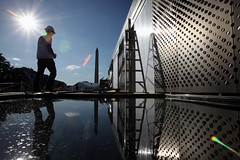 That is the feel that Virginia Tech’s Lumenhaus gives in their, quite simply, luminous website and presentation of their entry into the DOE Solar Decathlon, which opens Thursday on the Mall in Washington, DC, and which I had a chance to visit earlier today.
That is the feel that Virginia Tech’s Lumenhaus gives in their, quite simply, luminous website and presentation of their entry into the DOE Solar Decathlon, which opens Thursday on the Mall in Washington, DC, and which I had a chance to visit earlier today.
As the name suggests, Lumenhaus is a dwelling playing with light and living off it with extensive windows and both solar photovotaiic (electric) and thermal (hot water) systems.
The Lumenhaus’ system also has two-sided solar panels which seem to be a ‘new’ feature appearing in a number of the homes this year. These Sanyo panels, VT claims, have a 15% performance improvement over single side producing systems.
Control systems that ‘run the house’ automatically, including moving around louvers as the solar angle shifts. (While the owner could override this, the automation is aimed to maximize performance — whether heat gain / retention in winter or minimization / cooling in summer.) This means that the system is constantly monitoring system performance, weather and interior conditions, and weather forecasts to achieve the optimal performance not just for that moment but also for the hours and days to come.
“LUMENHAUS uses technology optimally to make the owner’s life simpler, more energy efficient and less expensive.”
These louvers are quite impressive, with laser cut ‘circles’, all bent to maximize light gain and minimize unwanted heat gain (thus, each of the 1000s of cuts is specific to that location on the louver). Seeing them on the mall, with multiple color reflections looking toward the Washington Monument was stunning (let’s hope the photos come out). The Lumenhaus Eclipsis system actually is more than ’simply’ these rather beautiful metal shutter shades, but also includes translucent insulating panels filled with aerogel.
All of this monitoring and automation means that the Lumenhaus, left to its own devices, will have a quite different look dependent on time of day, weather conditions, or time of year. As they ask, “does your home dress for the seasons?”
Wandering the Solar Decathlon is like being caught in a big candy store for the ‘eco-geek’ within, but it is also eye candy for the aesthetics’ oriented (even though, of course, the integration of technology into our lives has a beauty of its own). Already mentioned, is the changing nature of the home during the season, the beauty of the shutter shades yet there is much more. Watching the video, walking into Lumenhaus (even while under construction) creates an “I want that” moment, seeing it as an eminently livable space … effective not just in energy terms.
Truth be told, essentially every one of the Solar Decathlon homes creates moments and feelings of “I want this” or “what a wonderful approach” or … That is one of the reasons it is such an Energy COOL event.
Integrate Site Design--LUMENHAUS' Landscape Architecture
10/07/2009 by asladirt
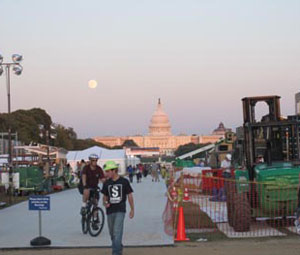
Solar Decathalon 2009 kicked off on the National Mall today. After receiving more than 40 student-generated proposals from universities in the U.S. and worldwide, the U.S. Department of Energy (DOE) narrowed the field down to 20 finalists that offered the most innovative, high-tech, high-efficiency, solar-powered homes. More than 800 students are competing this year. This is the fourth time the DOE has sponsored the biennial competition.
Each of the 20 student teams received $100,000 from the DOE but still had to raise some $400,000-500,000 to pay for the 800-square feet homes. The DOE spokesman said that by teaming up with a range of companies, the students were learning “real world experience” that will make them the “energy leaders of tomorrow.” Now in its fourth-generation, the Solar Decathalon is “pushing innovation and systems engineering.” Some homes include microgrids that can be run through an iPhone.
The homes will be judged by a team of architects, engineers, systems engineers, lighting specialists, and communications specialists on the overall architecture, engineering, comfort, marketability, appliances, lighting, and other aspects. The DOE said that not only must the homes be aesthetically appealing, but “they must also work.” Using only solar power, the homes must heat 15 gallons of water to 150 degrees twice a day; run all appliances; heat and cool the homes; and maintain temperatures of 72-76 degrees with 40-60 percent relative humidity. The judges have also added a home entertainment component. TVs, powered by solar energy, must be able to run for six hours per day. Additionally, six team members must live, eat, work within the homes from 10:00 AM to 6:00 PM every day during the competition.
The homes are being wired by local D.C. energy provider, Pepco, which has connected the homes to the central energy grid. Zero net homes will get 100 points at the end of 10 days but will receive an extra 50 bonus points if they return surplus to the grid, creating an additional incentive for energy-efficiency. The DOE says, “Solar is here to stay, and these homes prove that it works.” What the contest will prove is what technologies work best.
A number of student homes included integrated systems with landscape elements at their core:
Virginia Tech’s Lumenhaus
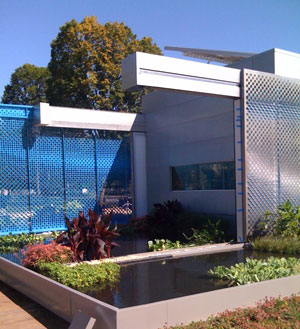
Ben Johnson, ASLA, professor of Landscape Architecture, Virgina Tech, said Lumenhaus’ site and landscape features were designed to contribute to the home enterprise and assist the solar-powered functions. Lumenhaus is “low-energy and high green,” said Johnson. Instead of a green roof on top of the home (which Johnson said the team decided not to use because of height restrictions), there are two types of green roofs that form terraces around the site. The green roof terraces are used for water treatment and lowering the home’s carbon footprint.
Johnson said recent research his department is conducting points to a fascinating number: 400-square feet of dense groundcover with a density of 32 leaves per square inch can sequester the C02 output of one person. Using these calculations, the Lumenhaus team determined the amount of plants needed for the site. For one terrace, the landscape architecture students involved in the project used sedum, which “sequesters carbon and doesn’t give it up, unlike other seasonal plants that dump their carbon during their lifecycle.” Additionally, the green roof terraces assist in solar absorption.
To assist with greywater mitigation, water output from the home’s sinks, dishwasher, washing machine, and other appliances, are infiltrated through the terraces and ponds in an integrated manner. Grey water is also used to water the green-roof terraces. “Theoretically, you can drink it,” Johnson added. Unfortunately, Johnson noted, it’s not allowed. The hydroponics help create the site dynamic but also solve the greywater problems.
Virginia Tech started on this project more than two years ago. “Landscape architecture students were involved from the early concept phase.” Virginia Tech won the competition in 2005 so wanted to “up the ante.” To do this, Johnson said, they needed an interdisciplinary design team that included electrical, computer, and structural engineers, architects, and landscape architects. Johnson noted that the landscape architect was the “lead on site,” while the architect was the lead during development. Johnson added that the site development / landscape component of the Solar Decathalon had improved dramatically from four years ago. The team thought siting the home in a landscape would also help them win marketability points.
The total project budget was around $600,000. SemperGreen UK and LiveRoofprovided elements of the green roof terraces, along with Oscar Warmerdam.
Solar Decathlon Puts Spotlight on Green Homes
Solar decathlon puts spotlight on green homes
October 7, 2009 - 3:57pmWASHINGTON - Think your home is green?
You won't believe some of the solar-powered homes being featured on the National Mall.
More than 800 university students from the United States, Canada, Spain and Germany are competing in the 2009 U.S. Department of Energy Solar Decathlon to build the most energy-efficient home
One of the homes - which are around 800 square feet - was built by a team from Virginia Tech.
Architecture student Christian Truitt says an iPhone application controls Virginia Tech's version of an energy-efficient home.
"The phone can move the insulation, the walls. It can control your lighting, your curtains," Truitt says.
A weather station inside the home monitors conditions and makes "decisions on what's the right action to take to protect itself and keep itself most energy efficient," Truitt says.
But the 20 homes making it to the final round can't just look good. They also have to prove they're energy-efficient by performing everyday functions like laundry, heating and cooling.
The solar decathlon is open to the public starting on Thursday. The winner will be announced on Oct. 16.
For more information about the U.S. Department of Energy Solar Decathlon,click here.
LUMENHAUS feature on Solar Decathlon website

Daily Journal - October 6, 2009
Emerging Technologies Define Solar Decathlon
It's nail-biting time as teams wrap up the construction process. All houses must be grid-connected by 2 p.m. tomorrow, with assembly completed and lots cleaned by 5 p.m. That gives teams less than 24 hours to finish. Most teams remain upbeat, but you can sense a quickness to the pace and a sense of urgency from others. A look at the time-lapse camera may give the impression that a huge amount of work remains, but you'll be surprised how fast things will come together tomorrow afternoon.
The solar village is like one big puzzle with highly innovative pieces. As they are fitted together and nearing completion, we learn more about what makes each house special.
The Virginia Tech entry, Lumenhaus, is a high-tech marvel. Movable wall systems make it instantly recognizable. Sliding polycarbonate doors filled with Nanogel can be opened or closed for heat gain or loss. The panels and shading screens perform a large portion of the heating and cooling functions through passive design. When fully open, they create a pavilion-style living space that blends with the outdoors. Another feature of Lumenhaus is its concrete flooring. Specially developed for the Solar Decathlon, the concrete is integrated with a flexible material that makes the flooring lighter and easier to transport, opening up all kinds of opportunities for modular homebuilders.
http://www.solardecathlon.org/2009/daily_journal_1006.cfm
Wednesday, October 7, 2009
Touring the Lumenhaus Solar House: Tech in skylight above the bathroom exposed.

Touring the Lumenhaus Solar House: Tech in skylight above the bathroom exposed.
Originally uploaded by curiouslee
Tuesday, October 6, 2009
Virginia Tech
more information:
www.lumenhaus.com
www.solardecathlon.org
www.facebook.com/lumenhaus
www.twitter.com/lumenhaus
2009 Solar Decathlon
Eclipses sun screens, right, and a gray water filtration system, bottom, reflect the sun off the solar-powered Virginia Tech house during the 2009 U.S. Department of Energy Solar Decathlon on the National Mall in Washington, D.C., Monday, Oct. 05, 2009. (Photo by Stefano Paltera/US Dept. of Energy Solar Decathlon)
Uploaded by Dept of Energy Solar Decathlon on 5 Oct 09, 8.44PM EDT.
Monday, October 5, 2009
Virginia Tech Lumenhaus Kindles Solar Possibilities
From Oct. 4 through Oct 17, 2009, the Virginia Tech Lumenhaus will be displayed on the National Mall in Washington, D.C., where it will compete against 19 other universities to determine which team has designed and built the most efficient, operational solar-powered house to address evolving quality of life issues.
 Joseph Wheeler, associate professor of architecture, is the lead faculty member on the project.
Joseph Wheeler, associate professor of architecture, is the lead faculty member on the project.
The major phases of the Solar Decathlon Competition include:
- Research: Students and faculty investigate all aspects of energy use in daily patterns of living. Interdisciplinary teams develop hundreds of alternatives synthesizing architectural intent with technological innovation. The theme of Virginia Tech’s solar house is Responsive Architecture and is designed to advance conservation as well as technical innovation.
- Building: The conceptual phase of the project proceeds through prototype development and testing. Alternatives are explored through full-scale mock-ups, drawings, models, animations, and computer simulations. This planning is validated or challenged through the act of construction. In addition to designing houses that use innovative, high-tech elements in ingenious ways, students work with fabricators, suppliers, consultants, and other professionals in a similar mode to the workplace they will eventually enter.
 Robert Dunay, the T. A. Carter Professor of Architecture, is one of the lead faculty members on the project.
Robert Dunay, the T. A. Carter Professor of Architecture, is one of the lead faculty members on the project.- Corporate Partnerships: With this fourth Solar Decathlon, the level of expertise and sophistication increases geometrically. Because of its past showings in 2002 and 2005, Virginia Tech is able to attract substantial corporate sponsorship. ConocoPhillips and Siemens are two of the many partners who have contributed cash, in-kind material, and services to enable the university to compete at an international level.
- Competing: Teams transport their houses to the National Mall in Washington, D.C., for three weeks of public viewing and competition. During the competition itself, the teams receive points for their performance in 10 contests.
Virginia Tech is the only university in the commonwealth represented in the U. S. Department of Energy Solar Decathlon competition. The teams, which were selected from universities in the United States, Canada, Spain, and Germany, were charged with creating houses that utilize energy-efficient technology and demonstrate that houses powered entirely by the sun do not have to sacrifice all the modern comforts and aesthetics homeowners are accustomed to.
Virginia Tech's Lumenhaus website includes a documentary, a video build-up that shows how the house is constructed from the inside out, detailed information about thetechnologies featured in the house, and a video experience of living in the house.
 The Eclipsis system is an advanced building façade comprising two layers: a metal shutter shade and a translucent insulating panel. The system was on display at the Taubman Museum of Art in Roanoke, Va., during the 2009 summer.
The Eclipsis system is an advanced building façade comprising two layers: a metal shutter shade and a translucent insulating panel. The system was on display at the Taubman Museum of Art in Roanoke, Va., during the 2009 summer.
The road leading to the National Mall
An exhibition about the Virginia Tech Lumenhaus was open at the Taubman Museum of Art in Roanoke, Va., June 12 – Aug 23, 2009. The exhibition showcased the house’s Eclipsis system.
The Eclipsis system is an advanced building façade comprising two layers: a metal shutter shade and a translucent insulating panel. The shutter shade slides along the north and south façades, providing protection from direct sunlight while simultaneously allowing for indirect, natural lighting, views to the exterior and privacy to those inside. The sliding insulating panel is a translucent polycarbonate panel filled with aerogel. Aerogel is a super lightweight, highly insulating translucent material that provides insulation equivalent to a typical sold wall during harsh weather conditions without blocking natural light.
The Virginia Tech Lumenhaus was on exhibition at the National Building Museum in Washington, D.C., Sept. 5-27. The house was displayed on the museum’s west lawn while the team tested the systems and components.
 Virginia Tech's 2009 Solar Decathlon team poses with their entry at the College of Architecture and Urban Studies' Research and Demonstration Facility, where the initial construction took place.
Virginia Tech's 2009 Solar Decathlon team poses with their entry at the College of Architecture and Urban Studies' Research and Demonstration Facility, where the initial construction took place.
The next stop
Virginia Tech is one of only two U.S. universities invited to compete in the first Solar Decathlon Europe, which will take place in Madrid in June 2010. The Solar Decathlon Europe competition is modeled on the biennial U.S. Department of Energy Solar Decathlon.
http://www.vt.edu/spotlight/innovation/2009-09-28-solar/2009-09-28-solar.html
THE SOLAR DECATHLON
For more information on events and workshops by day visit:http://www.solardecathlon.org/schedule.c
LUMENHAUS' last week @ the National Building Museum

Virginia Tech solar house on exhibit at National Building Museum Sept. 5-27
WASHINGTON, D.C., September 3, 2009 -- An innovative solar house that has been designed and constructed for the U.S. Department of Energy Solar Decathlon by a team of Virginia Tech faculty and students will be on exhibition at the National Building Museum in Washington, D.C., Sept. 5-27.Virginia Tech and the National Building Museum have a long history of collaboration. Through tours of the house and public programming, the museum and Virginia Tech aim to educate the public about the importance of sustainable design within the built environment. The Virginia Tech solar house, named LUMENHAUS, will be on display on the museum’s west lawn at the intersection of 5th and F Street, in Northwest Washington, while the team makes final improvements on the construction of the house.At 6:30 p.m. on Sept. 10, to augment the exhibition, the museum will host a panel discussion about how cutting-edge sustainable technologies are conceived, developed, and ultimately brought to the market. Panelists include: Richard King, director, Department of Energy’s Solar Decathlon; Paul Torcellini, senior researcher, National Renewable Energy Laboratories; Bill Sisson, director of sustainability, United Technologies Corporation; andLance Hosey, architect and journalist (moderator).For more information about the Virginia Tech solar house, visit the LUMENHAUS website. The website includes announcements about exhibitions; a documentary; a video build-upthat shows how the house is constructed from the inside out; detailed information about thetechnologies featured in the house; and a video experience of living in the house.Lead faculty on the Virginia Tech LUMENHAUS project are College of Architecture and Urban Studies faculty Joseph Wheeler, associate professor of architecture; Robert Dunay, the T. A. Carter Professor of Architecture; Andrew McCoy, assistant professor of building construction; and Robert Schubert, associate dean of research.Lead students on the project are Alden Haley of Glen Allen, Va., fifth-year architecture student; Corey McCalla of Rockville, Va., fifth-year architecture student; Casey Reeve of Shelter Island Heights, N.Y., fourth-year industrial design student, all in the College of Architecture and Urban Studies, also Brian Zaremski of Manasas, Va., electrical engineering graduate student; and Ji-Sun Kim of Blacksburg, a doctoral computer science student, both in the College of Engineering.
Thursday, September 17, 2009
Eclipsis System--Sun Shade Arrival
 The Sun Shade just arrived to the LUMENHAUS construction site (National Building Museum) today!
The Sun Shade just arrived to the LUMENHAUS construction site (National Building Museum) today!LUMENHAUS on TreeHugger
Virginia Tech & the Solar Decathlon: What About Us?
by Kristin Underwood, Sacramento, CA  on 09.10.09
on 09.10.09
Hot on the heels of the article about Penn State using Ed Begley Jr to earn them brownie points in the Solar Decathlon, Viginia Tech quickly shot back a post. 'What about us?, they said, we're in the National Building Museum in Washington, DC right now. Doesn't that get us any press and kudos for the competition?'
Virginia Tech's entry to the Solar Decathlon is currently on display and open to the public until the competition begins this October. The solar house, titled LUMENHAUS, an 800 square foot zero-energy home, will be on display but students and faculty working on the project will also be making adjustments during this last month - more like a living artwork, if you will. The house is designed to dress itself and you for the seasons and is smart enough to know when to add more light, less light, more heat or less heat. If you can't make it to DC, you can visit the house virtually on theirLUMENHAUS website, which includes pictures, videos and even footage of people living in the house.
The museum will also host an event September 10 at 6:30pm to talk about sustainable design and solar energy. Leaders from the Solar Decathlon, NREL and other green building gurus will be on hand to answer questions and talk about the future of these cutting-edge technologies.
The Solar Decathlon challenges schools to design a house that can produce enough hot water and electricity to run all of the functions of a normal home and the team at the end of the week with the most points wins. In 2005, the Virginia Tech home won fourth overall and first place in best architecture, livability, day lighting and electric lighting. The Virginia Tech team is also one of only two universities invited to attend the Solar Decathlon Europe in Spain, June 2010. :Virginia Tech News :LUMENHAUS
Virginia Tech's entry to the Solar Decathlon is currently on display and open to the public until the competition begins this October. The solar house, titled LUMENHAUS, an 800 square foot zero-energy home, will be on display but students and faculty working on the project will also be making adjustments during this last month - more like a living artwork, if you will. The house is designed to dress itself and you for the seasons and is smart enough to know when to add more light, less light, more heat or less heat. If you can't make it to DC, you can visit the house virtually on theirLUMENHAUS website, which includes pictures, videos and even footage of people living in the house.
The museum will also host an event September 10 at 6:30pm to talk about sustainable design and solar energy. Leaders from the Solar Decathlon, NREL and other green building gurus will be on hand to answer questions and talk about the future of these cutting-edge technologies.
The Solar Decathlon challenges schools to design a house that can produce enough hot water and electricity to run all of the functions of a normal home and the team at the end of the week with the most points wins. In 2005, the Virginia Tech home won fourth overall and first place in best architecture, livability, day lighting and electric lighting. The Virginia Tech team is also one of only two universities invited to attend the Solar Decathlon Europe in Spain, June 2010. :Virginia Tech News :LUMENHAUS
LUMENHAUS on Re-Nest
Lumenhaus: Green Home Inspired by Mies
You can read more about the Lumenhaus online or even fan it on Facebook. If you want to see the Lumenhaus in person, you can check out the unique Eclipsis panels at the Taubman Museum in Roanoke Virginia through August 16, or wait until October when DOE will erect a "solar village" on the National Mall and allow the public to tour the houses- we'll definitely be there for the big unveiling!
LUMENHAUS on Clean Skies News
Twitter Follow @lumenhaus
National Building Museum Exhibit

Sept. 5 - 28th see LUMENHAUS at the National Building Museum
Tour the house and watch the team complete construction and test house systems.
HOURS:
Mon.-Sat. 10 am to 5 pm
Sun. 11 am to 5 pm
More Information:
www.lumenhaus.com
www.nbm.org/programs-lectures/
